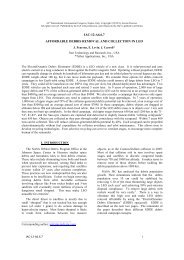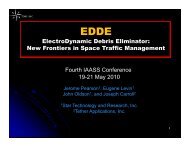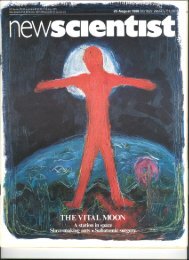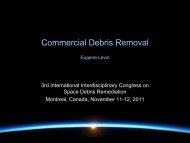The Cost of Future Collisions in LEO - Star Technology and Research
The Cost of Future Collisions in LEO - Star Technology and Research
The Cost of Future Collisions in LEO - Star Technology and Research
You also want an ePaper? Increase the reach of your titles
YUMPU automatically turns print PDFs into web optimized ePapers that Google loves.
30<br />
To put estimate (B5) <strong>in</strong> perspective, let us consider a commonly used formula<br />
N m = k (M/m) γ ,<br />
(B6)<br />
where N m is the number <strong>of</strong> fragments heavier than m, <strong>and</strong> M is the total mass <strong>in</strong>volved<br />
<strong>in</strong> the collision. <strong>The</strong> orig<strong>in</strong>al Kessler’s formula has k ≈ 0.8 <strong>and</strong> γ ≈ 0.8 [21],<br />
an early version <strong>of</strong> the NASA breakup model uses k ≈ 0.45 <strong>and</strong> γ ≈ 0.75 [18], the<br />
mass distribution <strong>of</strong> the tracked fragments <strong>of</strong> Solw<strong>in</strong>d fits k ≈ 0.3 <strong>and</strong> γ ≈ 0.8 [16],<br />
while the estimate (B5) corresponds to k ≈ 0.4 <strong>and</strong> γ ≈ 0.8 for M ∼ 1 ton. Extended<br />
formally toward masses over 10 kg, the estimated distribution converges<br />
with the early NASA model. Debris models are evolv<strong>in</strong>g [22], <strong>and</strong> new breakup<br />
models are <strong>in</strong>troduced [20, 23]. <strong>The</strong>y will become more accurate when more data<br />
on small fragments is gathered.








